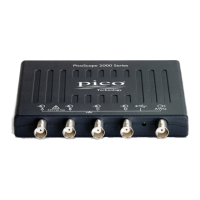Programming the 2000 Series Oscilloscopes
9Copyright © 2006–2022 Pico Technology Ltd. All rights reserved.ps2000pg.en-12
PicoScope 2000 Series Programmer's Guide
Example
1. Call
ps2000_set_channel
with range set to
PS2000_1V.
2. Apply a sine wave input of
500 mV amplitude to the
oscilloscope.
3. Capture some data using
the desired sampling
mode.
4. The data will be encoded
as shown opposite.
2.4 Triggering
PicoScope 2000 Series PC Oscilloscopes can either start collecting data immediately, or be
programmed to wait for a trigger event to occur. In both cases you need to use the
ps2000_set_trigger function or, for scopes that support advanced triggering, the
ps2000SetAdvTriggerChannelConditions and related functions. A trigger event can
occur on any of the conditions available in the simple and advanced triggering modes.
Available in block mode and fast streaming mode only. Calls to the
ps2000_set_trigger and
ps2000SetAdvTriggerChannelConditions functions have no effect in
compatible streaming mode.
The triggering methods available for your oscilloscope are listed in the data sheet. Where
available, the pulse width, delay and drop-out triggering methods additionally require the use of
the pulse width qualifier function, ps2000SetPulseWidthQualifier.
2.5 Signal generator
The PicoScope 2203, 2204(A) and 2205(A) PC Oscilloscopes have a built-in signal
generator, which is set up using ps2000_set_sig_gen_built_in. You can also use this
signal generator to output arbitrary waveforms, using ps2000_set_sig_gen_arbitrary.
PicoScope 2203, 2204(A) and 2205(A) oscilloscopes only.
2.6 AC/DC coupling
Using the ps2000_set_channel function, each channel can be set to either AC or DC
coupling. When AC coupling is used, any component of the signal below about 1 Hz is filtered
out.

